1 hour 30 minutes, 6.5/10 from 58,642
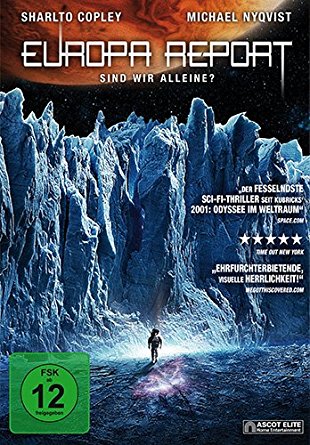
Sy Fy, drama, mystery, documentary, these are all terms that might apply to this film. In it a multi-national, multi-ethnic crew pilots a spaceship from Earth to Europa, a large moon of Jupiter. Europa is an ice world and where there is ice there might be now or once water, and where there is water, there might be life. That is why Europa.
There is not a uniform or rank in sight. This mission is that of private company. Shades of the Alien franchise.
The approach is near documentary and the time line is jumbled as new data is made available. The perspective is a forensic investigation into what went wrong, using video sent back by the ship. ‘Everything’ is the short answer. The company CEO reports on the mission … [to the shareholders]? It was amusing to imagine Richard Branson doing this, flipping his hair, flashing his teeth, and thrusting forward the hips, as he does.
We are treated to the starry firmament and the awe of the deep and dark unknown. There is much display of the tedious work of running a spaceship. William Xu is in command but there is much discussion, but no one ever calls him captain.
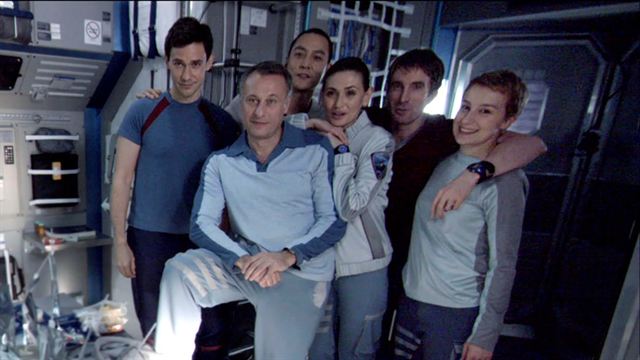 The crew before….there were none.
The crew before….there were none.
Repairs have to be made and are routine,… not all. One repair requires an EVA and when a bolt flies out, the first crewman is lost, drifting off into the void in radio contact for a while…. No bang, just a whimper.
They land on Europa, as per plan, leaving the orbiter above. It is indeed ice, but not solid. Hmm. Will the ice withstand the weight of the lander? It seems OK. They do some ice fishing, cutting a hole and dropping a probe down into…. yes, it is water. The data streams in, then the probe stops. Huh? What happened? An IOS update? Flat battery? One of the crew goes to change the battery and sees the ice cracking and… Two down.
Another one forgot to fasten the seat belt. Whack. Three down.
So it goes until only one is left.
These are explorers like those who went with Columbus, Lewis and Clark, Captain Cook, Marco Polo, Edmund Hilary, Robert Scott, Thor Heyerdahl, and their ilk. They want to know what is there, and send that knowledge back to Earth. Or the scientists like Marie Curie who exposed or injected themselves to their discoveries to see what happens.This desire to know kills each of them one-by-one like the Agatha Christie story shorn of the evil mastermind making it happen. Just the laws of physics.

The film is distinctive in good part for what is not there.
1.There are no meteors to provide an easy crisis. This is the oldest chestnut in the Sy Fy writer’s manual.
2.There is nothing military about the exercise, and no weapons of any kind were on show. No wonder the NRA banned it.
3.There are no political echoes from Earth of any kind. No scheming Russians, no holy Greenies, no nothing of that sort. In no sense is this mission to save Earth, another common trope omitted.
4.There are two women in the crew of six, and there is nary a word about whether a woman could be a scientist and a woman, etc. All that tiresome, trite, and trivial nonsense so favoured by scriptwriters of Sy Fy in the 1940s, 1950s, 1960s, and 1970s. Oddly, they got paid for writing such bilge. One hopes they are out of work today.
5.Although the mission is a private business there is none of the corporate chicanery beloved by the scripts in the Alien sequence. The CEO suppresses emotion at times recounting the fates of the minions.
6.There are daring deeds but no grandstanding heroics to pull off a miracle. It is realistic enough that most of the time crew members are wrapped in safety gear, which they do not rip off for close-ups pace ‘Arrival’ (2016). None have make-up like Sandra Bullock in ‘Gravity’ (2013).
7.There is no creature in this feature. Much to the annoyance of the monkeys at keyboards who have commented on IMDb and You Tube. Yes, they do find an amoebae of sorts in the water and that is life, and that is tremendously exciting, but that bug does not cause any trouble. It just is.
8.There is, mercifully, no comic relief. No character who tells jokes trying to be funny, emphasis on trying. This figure appears far too often and in many films the butt of the humour is woman. Glad to be rid of that.
9.And there is no salvation. They all die. Very lifelike.
Month: November 2017
‘Trans-Atlantic Tunnel’ (1935)
‘Completing the Channel Tunnel in 1940….’ are the opening words of this futuristic movie made in the depths of the Great Depression from the typewriter of the then recent German refuge Kurt Siodmak while in England.
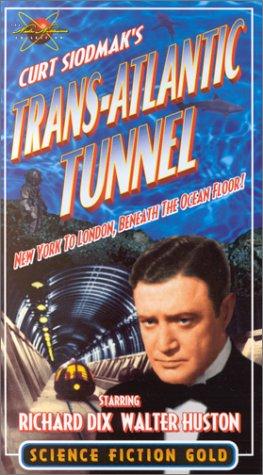
Face-time video telephone calls are common. Giant television screens in public squares, on outside walls, in railway stations are the source for news. Aerodynamic designed automobiles glide by. Non-stop transatlantic flights ply the airway from London to New York City and back. (The first non-stop flight on that route occurred in 1958). The face-time calls are also made from the airplane to home. The first passenger train took the Chunnel in 1994. As always Curt was ahead of the times.
The 1940 Channel Tunnel led to the development of a steel that can hold up the universe and a radium drill that churns through all matter and antimatter, too. The investors who paid for the development of those technologies want to see them used again for a return on that investment. The financiers gather to start the trans-Atlantic tunnel. Among them are many wheels within wheels. Some are motivated by philanthropy, others see in the Tunnel greater unity to prevent (another) war (though the Great War is never mentioned explicitly or implicitly). some are there for the likely profit, and then there are the merchants of death who think the tunnel (somehow, and this is never explained) will lead to war and increase demand for the armaments they have to sell.
There are three plot lines, which is three more than in some films reviewed on this blog. First is the Tunnel itself. Second is the personal life and relations of the Chief Engineer on the project. Third are the machinations of the financiers. Without a doubt the Tunnel is the star of the show.
The Tunnel is a gigantic maw that consumes money, labour, tools, lives, men, emotions, patience without end.

The five year project takes twenty. (Mega-engineering forecasts have not improved since then.) Chief is so obsessed by it that he does not notice his son or his wife. Wife tries to share his passion for the Tunnel by going to work as a nurse in it, where she contracts Tunnel disease from the gases and goes blind. Chief does not notice. Now blind (but evidently wealthy) she leaves him with the son. Chief does not notice. The son grows up. The Chief does not notice.
The daughter of one of the philanthropic investors is madly in love with Chief, married or not. Chief does not notice. She throws herself at him repeatedly. Chief does not notice. (This man needs glasses. Look at those assets.)
The financiers buy and sell Tunnel stock to drive others out of the project and Daughter sells her body to the arch villain to secure continued funding for the Tunnel. Chief does not notice.
Accidents, floods, power surges, equipment failure bedevils the project. These the Chief notices. He throw himself even deeper into the work. Workers die. The Chief does not notice. HIs son comes to work in the Tunnel. The Chief does not notice. His son dies in the Tunnel. At last the Chief does notice this, and united by grief he and Wife reconcile.
The Tunnel is vast, on two vertical levels with two way monorail traffic and a two lane road between the monorails.

Nothing like the dual tubes that comprise the Chunnel, which is still losing money. Its investors are still in the red.
Daughter discovers that life with the villain is exciting.
The British Prime Minister and the US President pontificate on the unity of the English-speaking people, though Canada, New Zealand, South Africa, New Zealand, Nigeria, the Bahamas, and Australia are absent from this incantation. Walter Huston does the US President whose pathetic pension meant he had to go to Mexico to find ‘The Treasure of the Sierra Madre’ (1948).
In the end, Chief has to do it himself. He does. End.
It got a laudatory review in the ‘New York Times’ and so it should. The design and staging are striking even today. Siodmak’s futuristic toys outdo ‘Metropolis’ (1926) and its successors like ‘High Treason’ (1929), ‘Just Imagine’ (1930), or ‘Non-Stop New York’ (1937).
The Chief was completely consumed by the Tunnel. How will he live now that it is completed?
It was made at a time when talkies were filmed in three (or more languages) in parallel. The props, costumes, designs sets, and story on the English version were used with a different actors and directors in French, and then again with another cast and crew in German. All this was done quick smart. Doing this led to huge multi-lingual and multi-national production facilities like Gaumont in Paris and UFA in Berlin.
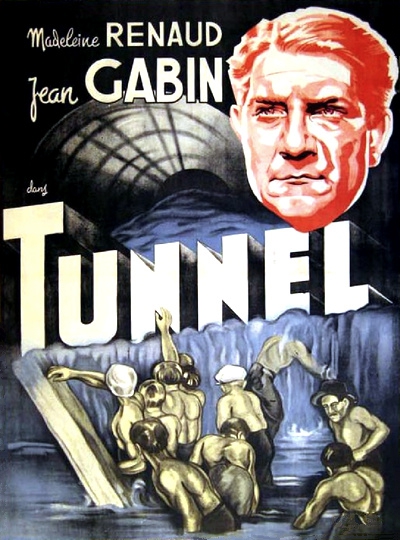 The French version.
The French version.
These polyglot facilities later opened doors for actors, writers, directors, designers, engineers, cinematographers, and others to move from one country to another after 1933.
From the IMDB, 1 hour 34 minutes at 6.2/10 from 548
‘Invaders from Mars’ (1953 and 1986)
‘They won’t believe me,’ should be the tag line for this story. It has been rendered twice. In 1953 it ran one hour and seventeen minutes scoring 6.6 from 5828 votes, while the big budget CGI version in 1986 is 5.5 from 5972 votes running one hour and forty minutes.
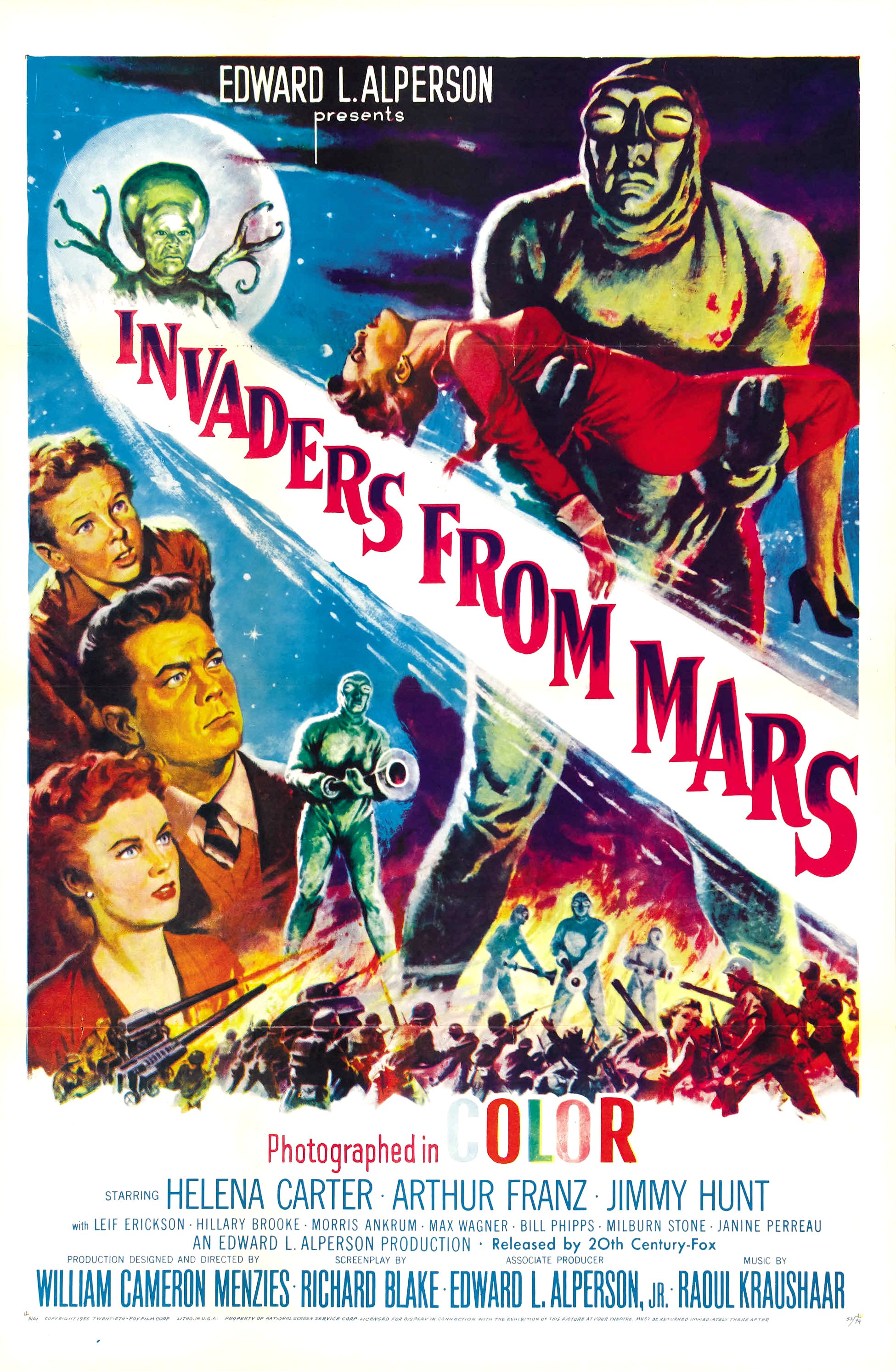 The 1953 lobby card makes it into a creature feature.
The 1953 lobby card makes it into a creature feature.
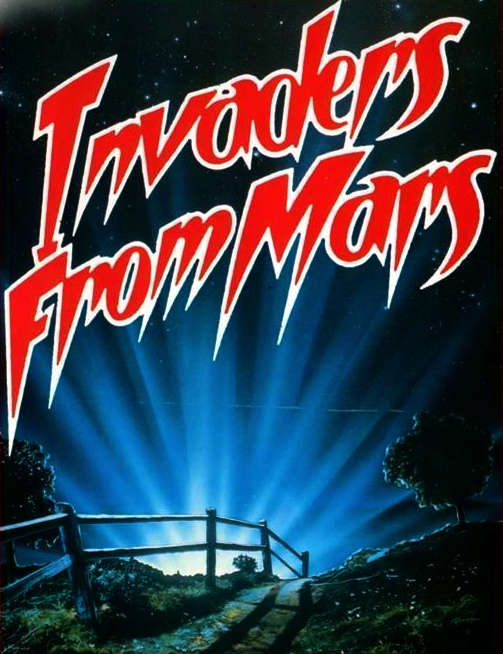 The 1986 cover.
The 1986 cover.
A boy of twelve is a star gazer, and he sees a bright light land just over the tree line. He convinces his dad to check it out. The re-make mimics the original in this scene and yet it is played differently. In the original there is mystery, while in the second it is explicit. In the original the loving father comes back from checking out the light a zombie in some kind of inner pain. While in the second he comes back an automaton with no interior. Leif Erickson in the original plays this transformation very well. He is no longer the loving father, but in distancing himself from his son, on his face we seen confusion and even anguish, while in the latter version the dad comes back an expressionless robot.
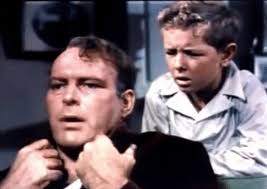
The subtlety of the original is lost in 1986. While in 1953 the persistence of the boy triggers events, in 1986 he is a midget Indiana Jones who makes things happen. Indeed at one point the Marine general defers to him. Ah huh.
Mind, there are some nice touches in the 1986 take, as when Nurse Ratched is caught eating a live frog, legs last. If only Red could have seen that. I also liked the unspoken reaction to the mother, now a zombie, burning a pile of bacon to blackened ruins and then calmly eating it. A frog, well that is odd but what do you expect from Ratched, but charred bacon is positively appalling. She must be an alien to do that. Burn it, I mean.
The only character in the 1986 version who bites into his role is the general who hams it up for all its worth. He, at least, knows it is a joke. While I loved the general, the time it takes him to blast the Martians was boring.This part was played in 1953 by that Sy Fy stalwart Morris Ankrum, of whom no criticism will be heard.
In 1986 Karen Black gives a a good performance but it does not match the material, but this woman can look worried, thoughtful, determined, and more. She is trying but …. its not enough. Yes, I know the boy is her son and perhaps that explains a lot. He seems to be stubborn, wilful, and blank most of the time.
There is far too much CGI of the Martians and their tunnel. It goes on and on and bored me. The rubber suit for the Martian in 1953 is preferable to this monotonous red CGI. The planet is red, see, so the Martian bugs are red, too, and everything around them is red, see. Yes, I saw.
In addition, I was never quite sure what the Martians were up to. Ugly yes, but what else? Yes, yes, I saw the NASA connection but I still did not fathom the point there, and since it is all boom-boom there is never an exposition, not at least while I was still engaged enough to notice. In 1953 it was clear they wanted to thwart the spaceflight but in 1986 there seems to be more to it, and less.
I liked the tribute of 1986 to 1953 in casting Jim Hunt, who was the boy in the earlier film, as the sheriff in the re-make. A nice touch.
OK, I admit I did some FF and may have missed the subtlety. While confessing, my comments on the 1953 version come from the Mind Palace, not a recent viewing.
‘Operation Ganymed’ (1977) and ‘Orion’s Loop’ (1981)
Operation Ganymed 1 hour 56 m 6.6/10 from 258 : Orion’s Loop 1 hour 25 m 5.6/10 from 78
These two Sy Fy movies have much in common with each other and with ‘Space Odyssey’ (1968) and ‘Solaris’ (1972). As to the latter they are post-modern avant le mot, ambiguous, incomplete, contradictory, unreliable, deceptive, all much like some …[fill in the blank] I have known.
‘Operation Ganymed’ from West Germany starts with astronauts returning after several years from a mission to Ganymede, a moon of Jupiter, which went wrong, leaving members of the expedition dead. (We never find out why Ganymed?) The five left are returning to Earth, among them Jürgen Prochnow, in a hurry to get to Das Boot. These survivors are dazed, battered, and anxious as they power home. The anxiety turns to angst as they near the blue dot because there is no radio communication. They keep calling but no one picks up, and yet they are sure their radio is working. If they cannot get ground help, it will be hard landing. Siri! Wake up!
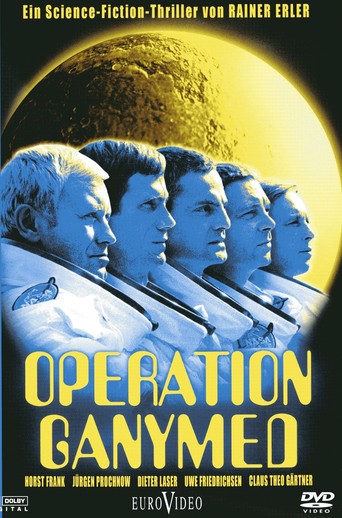
As for the Russkies, there are many space ships out and about and recently a number of them have come to grief. No, not by coming across Rush Limbaugh broadcasts, nothing that awful. Rather some unknown kind of radiation is penetrating the ships and driving the crews mad, and killing many of them. Video evidence from an Italian space ship shows the crew, eschewing pasta, and bashing into walls in their orange jumpsuits, double knit with flared trousers. Hold on, any Italian made to wear such a clown-suit would surely contemplate suicide.
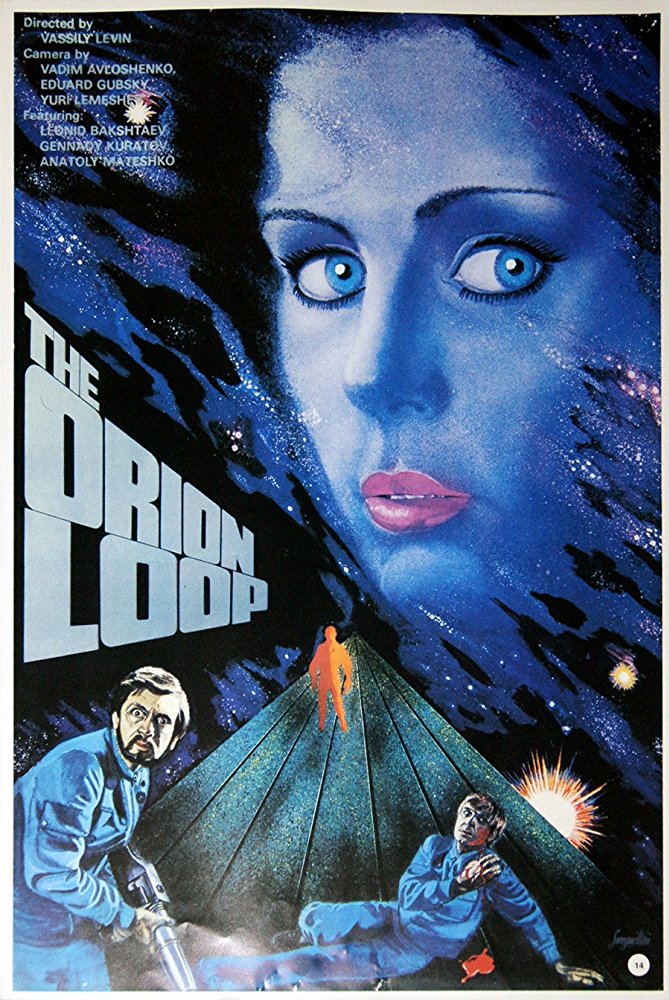
A committee meets. [Shudder.] Pontificating follows. Ditto. Ditto. The Libras want to study the phenomenon for a while, maybe forever. They can see research grants galore, fulfilling their KPIs, until retirement. The Taureans want to get out and taste the radiation. The noble Russkies agree to lead the mission in purpose-built ship they have whipped up. There were eight or nine of them. Each is cloned into an android to ease the burden. This gimmick is not integral to the plot and used in only two scenes. Much ado about little. The androids do not seem to be proof against the brain pain radiation later.
Distracted by the hijinks of the fraternity brothers, this correspondent missed some details, now and later, in both films. Ahem.
The Germans have no help and have to land hard and out of control. Surviving the landing, they emerge from their craft rocky and rolling after years in low gravity space. After some this-and-that, they guess that they missed the Pacific Ocean! Instead they are in Baja California near that ocean.
That is the mystery. What happened? Where is everyone? Meanwhile, how are these weakened men with only a few leftover supplies from a four-year mission survive in the harsh desert conditions in which they now find themselves? This environment is as harsh and forbidding as any Martian landscape shown in other Sy Fy films.
While the imperatives of the operation on Ganymede and then the concentration required to return kept the five cohesive and sane, this empty desert weakens those bonds. Injuries, delirium, dehydration further impair them. They head north and come across a few abandoned trucks and a few empty villages at crossroads. But no people, dead or alive, nor any animal or bird life. Just that rugged, endless, dry stony desert under a relentless sun.
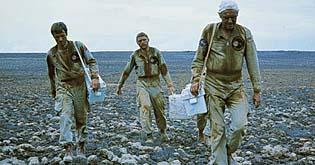 The walk.
The walk.
We then get the dreams and nightmares of the individuals. I loved one who dreamed of being the only survivor interviewed by the media while himself dying. The carrion of the media attack him with a battery of trivial and stupid questions, oblivious to his mortal distress as he dies under the barrage of their self-serving and aggressive questions. It seemed so plausible and realistic it could have been on the ABC.
Another stunned astronaut, blinded by the sun, imagines himself in a ticker tape parade of welcome.
A third has disconnected, blurred flashes of what happened to the others on Ganymede.
This parade of delusion interspersed with conflict among the five, though they are too exhausted for much.
On the other fork in the space-way, the Russkies are nearing the energy source which is cotton candy whirling in space. Their craft has all manner of special shielding, such as applied to those about the go to a dean’s budget briefing, but even so members of the crew start experiencing brain pains of considerable magnitude, though not as bad as though endured by budget meetings. It kills some. Even the androids need Tylenol. Others put on headphones to listen to Reiki music to recover. (Well, that is what it looked like, and I missed some the subtitles.) The crazier ones want to destroy the ship by pulling the USB cables out without ejecting the device in the prescribed manner! Unsafe withdrawal! That is a death wish! Others just want to go home. More die, though there is no gorefest. They just creep off and lie still. Kind of like Alexander Technique exercises.
 Barnard’s Loop stands in for Orion’s.
Barnard’s Loop stands in for Orion’s.
Whoa! Other members of the crew get holographic visitations that seem to be communicating with them. It takes a while to tune into the channel, but when they do, the message is, ‘Wait! I am not a dream. Listen.’
These visitations cause pain to the one visited, like when the in-laws come for Thanksgiving. The holographs have been trying to tune their visits so as not to kill those visited, something in-laws never do. The holographic visitors do some Geordie Speak and claim that they are there to help. Ah huh, this is after killing the crews of several other ships with these brain-pain inducing visitations. The energy field called Orion’s Loop, which the holographs have created, will save Earth from a speeding orb on a collision course, not yet sensed by Earth’s primitive instruments. Ah huh. But Earthlings must not interfere with the Loop. (Why did I just think of El Trains in Chi Town?)
‘We come in peace. We are here to help.’ That is what the holographs say as they flicker in and out. The visits seem to take a lot out of them, too. Why they did not try FaceBook is unknown where all the other weirdos go. The Russkies have heard all that before. Said it even. Some think it is a trick and without ejecting pull out more USB peripherals, while others dally with these spectral visitors. Dally. Pull. Dally. Pull.
Then it ends.
Back to the Germans. A couple of the wandering astronauts die in the desert.
Then it ends.
‘Operation Ganymed’ is a character study as each of the survivors deteriorates. While ‘Orion’s Loop’ shows the reactions of crew members to these alien apparitions.
Both movies have effective set designs, especially the Russkie computer, which is walk-in, like the one that used to be in the computer museum in Boston. The spaceships, the space suits, the instruments, especially in the German take, all have a verisimilitude to this viewer. Though the Germans are always complaining about what junk their Audi ship is. Whinge. Whinge. Whinge. It got them there and back.
Both movies are like ‘Odyssey’ and ‘Solaris’ in being cryptic, and it is left to the viewer to get something out of them. OK. Not something I would pay to watch, but far preferable to the Italian Sy Fy I have seen where there is a story and plot and both are confused and nonsensical, and evidently forgotten by the cast half-way through. No loss.
‘The Lost Missile’ (1958)
At 1 hour 10 minutes, 5.3/10 from 417 casters.
A missile appears on Soviet radar and the response is measured but finally an effort is made to intercept and destroy it. It fails, while intelligence reports that the missile did not originate in the USA or its allies. Huh!
The Soviet interception, while it did not disable the missile, deflected it into an Earth orbit. Around it goes at such great speed that the heat and sound in its trail destroys all. The new course will bring it over New York City in an hour. The countdown begins. (Note: the Russkies did it even they did not mean to do so.)
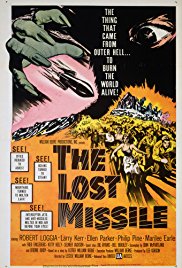 A misleading lobby card because there is no creature in this feature.
A misleading lobby card because there is no creature in this feature.
In Gotham we learn that a really big missile called Jove is soon due for a test flight at nearby Havenbrook. In New York City itself other scientists are making a bigger and better bomb; all are enlisted in finding a way to eliminate this threat. Among them is Robert Loggia, he of countless television programs, who spouts Geordie-speak and proposes to use Jove to carry the bigger and better bomb to blast the Lost Missile. He and his colleague Philip Pine, another TV regular, set to work against the clock. Tick, tick, tick…
Will exploding a hydrogen bomb in the atmosphere near New York City be wise? The Geordie-speak covers that. As the missile continues, it destroys Ottawa; no one noticed.
Only Philip Pine even wonders where the missile came from or with what intent and that is brushed aside by Loggia. Who cares? Let’s blow it up! Though admittedly, communicating with the silent runaway does not seem the obvious thing to do.
To get the plutonium bomb from New York City to Havenbrook, Loggia puts it in a Macy’s bag and sets off with his fiancée in tow. Sure.
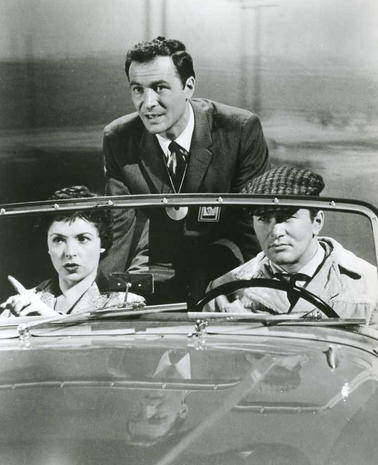 Loggia rides to the rescue and his own demise in one of his few leading roles.
Loggia rides to the rescue and his own demise in one of his few leading roles.
He sacrifices himself to arm the missile and launch it in the best Hollywood manner by installing the shopping bag in the missile, handling the plutonium. As crude as that it is, this is one of the few instances of movies of that era that emphasises the deadly radiation of nuclear weapons and atomic energy. Contrast that to ‘The Atomic Man’ (1955) where radiation is an annoyance to be treated with soap and hot water followed by a lie down and an aspirin.
Meanwhile, New York City is evacuated and those that stay in Gotham imitate Brits in the Blitz and gather in air raid shelters in a tense but calm manner to do the crossword puzzle. As if…
In between this action we see a lot, too much, stock footage of rockets, airplanes, weapons, wreckage, city streets, panic, and so on and on. These inserts seem promotional videos for the Air Force, for Conelrad, for NORAD, for Civil Defence, Macys, for…. One of them showed school children calmly crawling under their school room desks which would… (Remember that drill? I do.) Those inserts are good quality but pointless in the story. Perhaps sixty percent of the screen time is this padding. That made me wonder if the story was originally conceived to be shorter for a television playhouse program and then padded with this footage to B movie length.
The action with Loggia and company is well acted and briskly directed, but there is too little of it. Given that there is nothing about the origins of the missile, despite the misleading lobby cards with the hoary hand releasing the missile, it is hardly Sy Fy. We are none the wiser after it is blasted. Hope it does not have any siblings.
Again unusual for the time, the Soviets are shown to be cautious and the population of New York City includes blacks. Both are unusual for the time.
Common to the times is the role of the women to panic, cry, shout, and so on. Loggia’s girl is a scientist but you’d never know it after the introduction. She performs the stereotype duties well enough but there is no hiding how tiresome those duties are.
‘The Astral Factor’ (1976 and 1978)
3.7/10 from 575 at 1 hour 25 minutes
A slasher movie with invisibility and no slashes.
A convicted murderer reads a lot. Strange. He murdered his celebrity mother because she ignored him. HIs reading has given him telekinetic powers and also the on/off switch for invisibility. Wow! Mrs Hoover was right in the sixth grade when she said reading broadened the horizon.

The cast includes some name-recognition players: Sue Lyon, Elke Sommer, Leslie Parrish, Stephanie Powers, and Marianna Hill. Most of these women get one scene where they pretend to be strangled by an invisible man. Put that on the demo tape. On the other side, Percy Rodrigues is wasted though he imparts gravitas and integrity to a cardboard role. But the male lead is Robert Foxworth, about whom more later.
Back to the crazed killer.
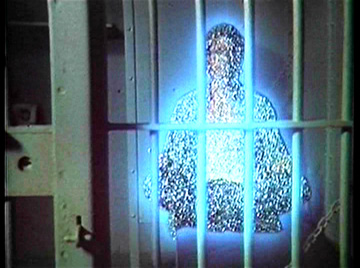
His reading homework done, the villain, Sandman, uses his telekinetic powers and invisibility to escape the slammer and mow down the those enumerated above. The only incident that engaged the jaded attention of the fraternity brothers was the murder during a modern dance performance, and that was the choreography. Honest!
To get ‘The Invisible Strangler’ (alternative title) the master plan is to bait him onto a stairway and then remodel the house with gunfire. The bait at the top of the stair is Elke Sommer. Well, that would work. A step is loosened under the carpet so that it squeaks. Set! Wait a minute, who put the cat out?
Sandman is duly riddled in an NRA-approved fusillade. For about five minutes. End. Though how they know he is dead remains a mystery since he is still invisible, or did I blink.
Did not these people watch any of the Invisible Man movies? Evidently not. To flush out an invisible man or woman, blow smoke, pour water, vent steam, spray insecticide, use paintball, something. But not here; instead it is a hail of bullets.
To attract the slasher demographic the alternative title was used when it was finally marketed. ‘The Astral Factor’ is never explained in the film anyway, and it would just confuse the anti-vaxxers. Mondays do that, too.
There were no special effects. No floating glasses, moving telephones, and since he strangles there are no wafting weapons. Nor is there any problem with invisible clothes and shoes or going bare and barefoot. Nor is there ever any explanation of how Sandman does it. Who cares anyway? (But which book was he reading? )
It was made in 1976 but not released until 1978 for the desperate VHS market of the day.
Seeing Robert Foxworth reminded me of one of the most enjoyable movies that has ever come my way, ‘The Black Marble’ (1980). It is a police procedural that is sad, funny, romantic, idealistic, pragmatic, has dogs, a chase, singing, and gave me an appetite for St Petersburg Russia, which was satisfied in 2017, though not in August. I re-read Roger Ebert’s laudatory review from the time and agreed with every word and sentiment. Foxworth is the movie but it helped to have that Amazon from Texas, Paula Prentiss, and the desiccated Kentuckian Harry Dean Stanton alongside. Joseph Wambaugh, the author of the novel, one of many, felt that previous Hollywood renderings of his books were stupid and superficial, so he decided to do it himself with this one. He succeeded! Chapeux!
‘This is not a Test’ (1962)
A boring film of 1 hour and 13 minutes about a nuclear apocalypse. It is marked as 5.5/10 from 557 time wasters.
A highway patrol officer in the Alabama Hills near Los Angeles is ordered by radio to set up a one-man road block in the middle of nowhere because a fugitive is about. He complies.
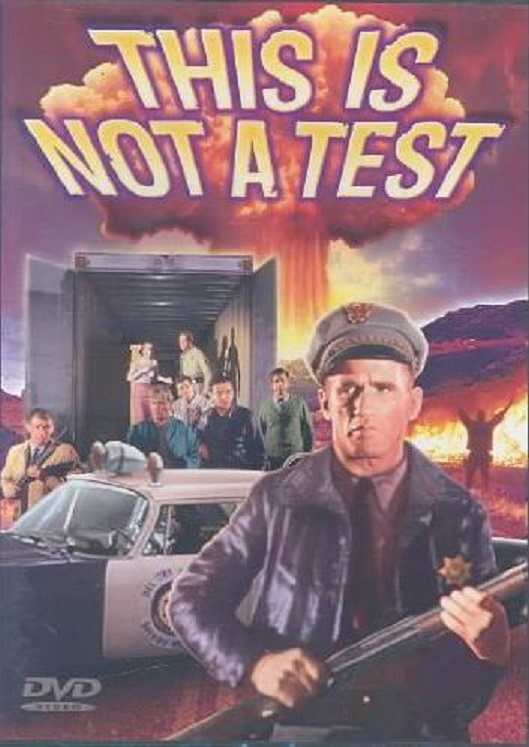
For nowhere there is lot of traffic and each time he orders the driver to stop, pull over, and wait without a word of apology or explanation. Send him back to the training course, cried the fraternity brothers. The motorist are varied.
Yes, this the Otranto roadblock where a mixed group of individuals are thrown together by larger, external events and must interact with each other. A disaffected wife sneaks off into the bushes, unbuttoning her blouse with the virile truck driver, a worried businessman has to fly to Mexico, a drunken socialite wants more liquor and her ageing beatnik boyfriend wants to match macho with the police officer who promptly clocks him with a rifle butt. This is a man of few words.
Copper forbids them from returning to their vehicles and has pocketed all their keys, hence no one can listen to commercial radio. The only source of intel is the police radio which begins to talk about evacuation of the city with the title phrase, ‘This is not a test.’ Everyone of a certain age will recognise the title as the Conelrad alert for atomic armageddon. Sixty minutes is mentioned as the time to….. Transmission ends.
The police officer redoubles his efforts to keep the party together, get those two out of the bushes, whack some sense into the would-be beatnik, kill the socialite’s annoying dog by strangling it, and coerce the truck driver and his off-sider to empty the truck. Why? So that it can be used as a bomb shelter! Yep. Well it is better than nothing. That was one training course he did.
So they crowd into the Otranto moving van truck which just happens to have a supply of canned food and bottled water, well beer. There was not much bottled water in 1962. Everyone in the truck feels sorry for themselves and has to decide how to live the remaining hours of their lives. Mostly they stand around saying that. They need an agenda and chair to focus the discussion. They need a McKinsey-speak manager to confuse things properly with micro-managed KPIs.
One hopes that in the truck’s supplies there is plenty of deodorant, because they may have to stay there for months. So it is said. It varies between oblivion in sixty minutes or months of waiting while the radiation dissipates, and that seems to be realistic in a way. Who knows? Who has tried to sit out a nuclear war in a truck before?
In 1962 nuclear war was a reality though the Soviets are never mentioned, and there is no chest-thumping about the American way in the back of the truck. Ergo it is certainly of the time but subdued. There are many films with a similar setting, like ‘Five’ (1951), ‘Alas, Babylon’ (1960), ‘Ladybug, Ladybug’ (1962), and more. Each of these three has a lot to offer.
Like many of those other films this one is intended to be a taut character study, but, well, it never had a theatrical release, not even for the triple feature drive-in market, where the cheap schlock was always welcome, and it is easy to see why. It is not taut though it is confined like a stage play. The writing does not produce or reflect tension though it is combative. The characters are so shallow, who cares. The more so when compared to the films named above. It seems to be the only credit for the director, screen writer, producer, and lead actor. The cinematography is either bleached or shadowed.
The Easter Islander playing the lead is monosyllabic and seems to have no inwardness. Some the players are familiar like Thayer Roberts, the farmer driving a crop to market and Norman Winston as the husband who shoots himself, not at the prospect of incineration but because it was his wife off in the bushes with the truck driver. In the hills the fugitive is still after the one-armed man.
However, despite its qualities, the film brought back a lot of unpleasant memories from that time and place when nuclear Armageddon was a prospect. The drills in school. The repeated testing, as in ‘This is a Test’ of the Conelrad network. The public service announcements on television about taping windows in preparation for annihilation. The ominous announcements in October 1962. Then there was the ordinary high school day when we were sent home early without explanation. Gulp! I have never been able to watch ‘The Day After’ (1983) because I thought I would relive that.
‘Munich’ (2017) by Robert Harris
A novel about two underlings in the negotiations at Munich in 1938. Years ago I read Georges-Marc Benamou’s ‘The Ghost of Munich’ (2009) concerning the late-life recollections and reflections of
Édouard Daladier, the French Prime Minister who took part along with Neville Chamberlain.

The stereotypes of this episode are many and seldom varied. Too bad. Harris, as always, digs deep into the strata and finds complexity, contradictory strands, variation, mixed motives, and men in way over their heads in deep and dark water where there is no bottom to touch.
In the main the reader looks over the shoulder of the youngest of the private secretaries in Prime Minister Chamberlain’s office, Hugh Legat. At times we see his Oxford friend, Paul Hartman, sometimes it is implied ever so delicately that they were very close and more than friends, who has become a translator in the Wilhemstrasse Foreign Ministry. They meet at Munich.
Much of the novel demonstrates the great pressure Chamberlain was under to find a way to peace and avoid another blood bath, his heart-felt desire to do that, his unflagging energy even at age seventy to pursue every last chance to the Nth degree, and his creative strokes in keeping the peace-process, as we have since learned to call such negotiations, alive on the assumption that talk-talk is better than kill-kill. He emerges as a good swimmer destined to drown in a mighty tsunami.
While the sniping from the Churchill lobby is noted, the real problem is always Hitler. He is the swirling eddy sucking everyone else into the maelstrom. Harris is a master of the detail of the Nazi regime down to the buttons on the uniforms of the waiters, and yet if comes across easily.
Chamberlain’s most creative stroke was to draw Benito Mussolini into the conference and that did buy several days, a week even. Hitler could hardly refuse the participation of his one and only ally, and Mussolini liked a stage and made the most of it with his prolix German and French. But here he is relegated to the wings.
Daladier said virtually nothing, so exhausted and preoccupied was he by the back-stabbing and internecine struggles in Paris that he spent most of the negotiating sessions making plans to do down some of his host of opponents at home. Among his own dwindling supporters some rallied under the banner ‘Better Hitler than Blum,’ the socialist Jewish alternative.
Chamberlain’s second stoke came after the partition of Czechoslovakia was agreed; it was to extract from Hitler that piece of paper he brandished at Heston aerodrome. At the end of the formalities in Munich he asked for a private meeting with Hitler and presented Hitler with a joint statement that paraphrased one of Hitler’s own recent speeches about peace. Clever that. Although Hitler had no interest in seeing Chamberlain he did so, he said, out of courtesy. Still less did he want to issue a joint statement, but he could hardly repudiate his own words just then. Moreover, it was just a piece of paper so why not sign it, if for no other reason than to get Chamberlain to leave. So he did and he did.
Chamberlain is shown to be a terrier about details throughout and to have an encyclopaedic grasp of the situation. He is also aware of how greatly people wanted peace.
Indeed, one of the interesting elements in this telling is the jubilant popularity Chamberlain had in Germany where the women and men in the street saw him as a messenger of peace, and cheered his every appearance. They crowd around the hotel and call for him to appear, but he does not do so in deference to his host. This popularity annoyed Hitler, who darkly grumbles about the problems with Germans weakness.
There is much in the book about how the PM’s office worked, relations with the cabinet, and with the Foreign Office, that shows the stage machinery of such dramas as well as the rivalries. As always Harris has immersed himself completely in the subject. Likewise, we read much about how Hitler’s entourage was organised at the time, as Hartman is drawn into it, and then recoils from it.
Legat and Hartman have their own private dramas but the master narrative that unites them and propels the book is this. What if Chamberlain (and Daladier) knew for a fact that Hitler’s intention was to go to war? Would that knowledge have led to a change at Munich with a different result?
I included Daladier about in parenthesis though there is virtually no liaison with the French shown in these pages. The French were paralysed by their own domestic strife and were present only in body. In Benamou’s novel Daladier is fatalistic. War is coming and there nothing to do but wait, and then he had faith in the Maginot Line. He is more worried about the prospect of a French Civil War similar to that in Spain.
Legat and Hartman offer such proof of the bellicose intention, and Chamberlain refuses it. Intentions can change, he may have believed, and maybe here today we can influence that change. Moreover, there is no advantage in being seen to be the aggressor. He is perfectly aware of the fact that a signature on a peace of paper will not stop Hitler from doing his worst, but it will give England the moral high ground. And it might delay the inevitable if it is inevitable for a few more days.
Furthermore, Hartman’s suggestion that an aggressive Britain would precipitate a coup d’état against Hitler is so much wishful thinking. Everything the Brits saw in Munich convinced them that Hitler had complete control of the country and that fit with every other source of intelligence they had. To be sure there were dissidents but they were but fleas.
Appeasement to use a word that barely figures in this text is the term usually associated with the period immediately before World War II. In its earliest days, when Germany reclaimed the Saar, and the Rhineland, and unilaterally cancelled some debts, appeasement was a positive policy by England, France, and Italy to assuage some of the injustices of the Treaty of Versailles, which had been imposed upon Germany at the insistence of Georges Clemenceau who wanted forever to cripple Germany. Subsequent French governments wanted, not to ease the German plight, but to strike at Clemenceau’s legacy for momentary political advantage, and so acceded to British initiatives to relent. The Brits wanted a German bulwark against Communism from the East.
But the demands from Germany continued, and no one in France or England wanted another war. While England and France had won in 1918, the war nearly destroyed both. Peace was popular, very. In addition internal political turmoil in France was paralytic as its own fascists were inspired by the Italian and German examples and the Spanish Civil War. Italy soon went with the wind into Hitler’s camp. The French hated each other more than any enemy and locked themselves in a battle to the death; that is no exaggeration because there were assassinations and beatings aplenty.
Chamberlain had learned the value of publicity and ensured that the press with BBC news cameras were waiting his return, though Harris is silent on this point, and in the wind after a rain shower he made that much quoted remark with that peace of paper in his hand which promised ‘Peace for our time’ but I have heard it said that this seventy year old after the arduous days in Munich where there was little sleep and no rest misspoke and meant to say ‘Peace for a time.’ By that measure it was a success.
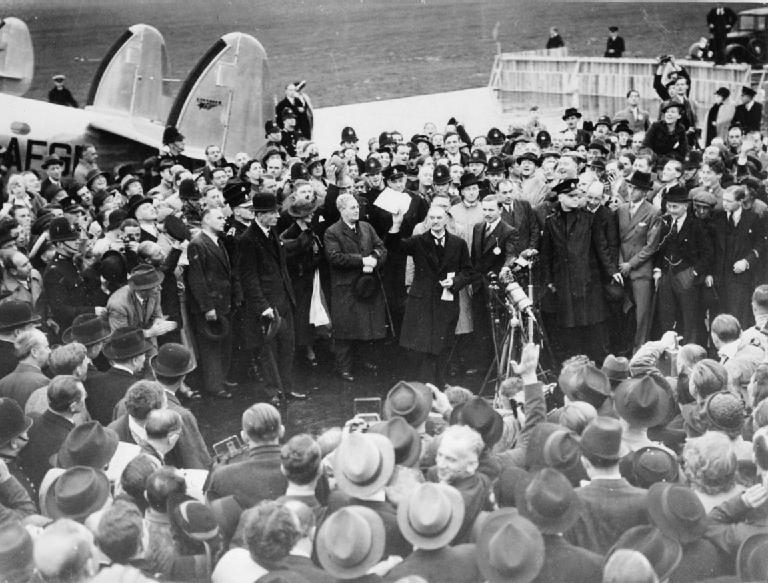
It is certainly plausible but Harris passes on this possibility in silence.
That possibility reminded me of Neil Armstrong’s much quoted 1969 remark ‘one small step for man, one giant leap for mankind.’ Wikiquotes now does Armstrong the service of inserting an indefinite article in from of the noun ‘man’ so that it reads: ‘one small step for [a] man, one giant leap for mankind.’ But accompanying sound file has no ‘a’ in it. The commentariat has been squeezing ego-time out of that ever since.
What else then could Chamberlain do but buy time, and hope against hope that the winds might change, and those cheering crowds in Munich heartened him, though his long political experience meant that he did not bank on an enduring vox populii.
For some years I was an HSC examiner and read each night for three weeks countless, well in fact they were counted — eight an hour — handwritten scripts on Modern History examinations on appeasement and this era. The words occasionally swam before my eyes but on it went but I learned a lot, about both the subject matter and the high school examination process, though as to the latter I was disappointed by its mechanistic rigidity, no paper could be awarded the highest grade of twenty unless it had mentioned every possible point on the list, emphasis on list. Out of the scores I read there was an outstanding one that was intelligent, well written, insightful, and probing but which, because of its tight focus, omitted a single point on the checklist and so, despite my advocacy, it was docked. That still rankles all these years later. (There were many other good ones but I refer to the one I tried to promote. Thereafter I learned my lesson and did not push.)
While indulging in autobiography, I spent a day in Munich in 1983 in a driving rain that inhibited much sight-seeing but I did find the bookstore that figures in a few episodes of ‘Derrick,’ a long running German cop show on SBS.
‘End of the World’ (1974 and 1977)
Starring Christopher Lee and Lolita, this was released in the same year as ‘Start Wars.’ That is the only thing they have in common apart from the genre classification of science fiction. This one is in the class ‘End of the World’ films like ‘Doomsday Machine’ (1967 and 1972) reviewed elsewhere on this blog and watched on consecutive nights. Contra T. S. Eliot on both nights it ended with a bang, not whimper. ‘Start’ for ‘Star Wars’ is the fraternity brothers’ idea of a witticism, since that first film started the endless franchise that is still with us.
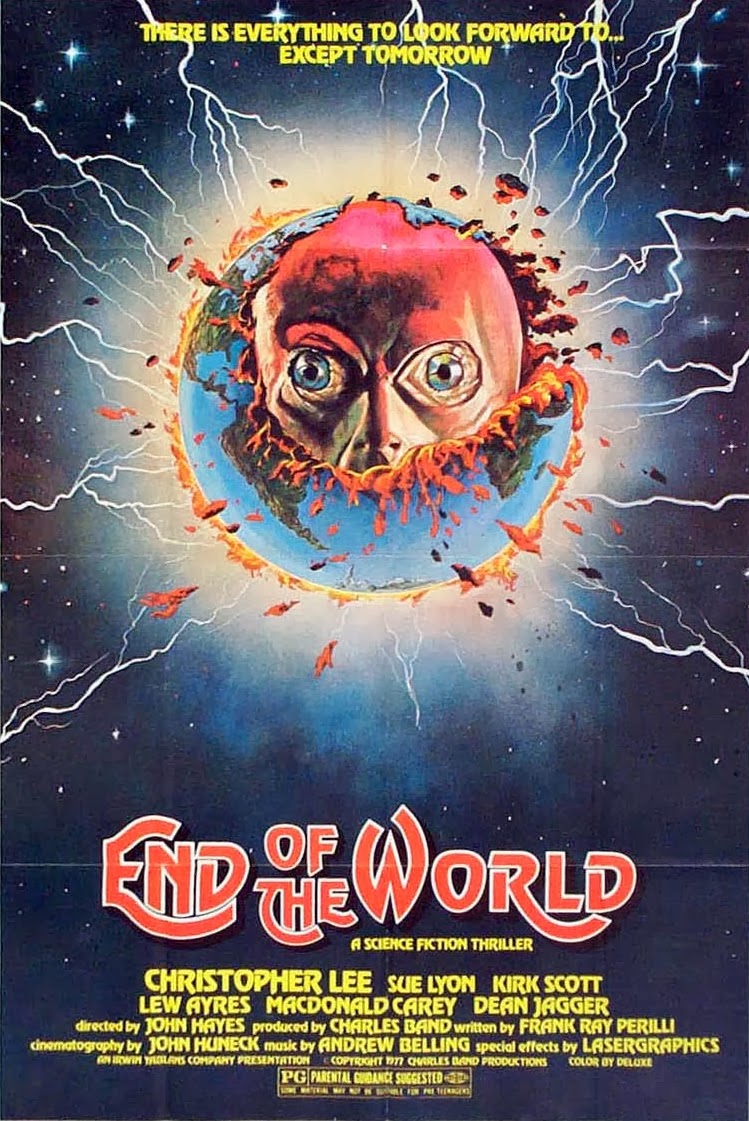
This entry runs feature length of 1 hour and 28 minutes; by the end we all wanted it to end. The End of the World was a small price to pay for the relief. On the IMDB it rates 2.9/10.0 from 654 votes. That comes in below the average excrescence from Adam Sandler, but 0.5 ahead of ‘Doomsday Machine.’
It starts well, and that has trapped a lot of viewers per the comments on the IMDB. The cadaverous Lee in a Catholic priest’s garb with a vacate look blunders into an all-night dinner; no one else is there but the attendant. Lee is sub-verbal, like a 7MATE announcer, but looks like the survivor of a car wreck. Stunned, dazed, off-centre, and muttering about calling the police. OK.
Then the telephone explodes off the wall! That’s Telstra service! Anyway, then the coffee urn explodes and the whole place goes up in blazes. Lee stumbles into the dark and ends up in front of St. Demon’s church, where he is greeted by …. himself! This is a mysterious start…and most of the mystery ends there, too.
Meanwhile we see Square Jaw sitting at a 1970 dumb computer terminal in a room full of clicking, spinning, blinking gizmos, so we know this is hi-tech. We see a lot of him sitting. He’s good at it. Sometimes he smokes a cigarette in this hi-tech environment. Then he sits some more. Occasionally he furrows his frontal lobes. Is this gripping or what? “Or what,’ said the fraternity brothers.
After what seemed like twenty minutes of furrowing, he says he is receiving messages from S P A C E. No one cares. His boss, the redoubtable Dean Jagger (what porkies was he told to take part in this travesty?) wants him to get back on schedule and forget this nonsense. Stick to the KPIs! Lolita just wants to party.
There must have been a sweet talker in the production because some of the footage is from the Rockwell plant where a space shuttle is under construction. This part is limited but it is impressive.
In the best tradition of a earlier era, Square Jaw takes Lolita hither and yon. No doubt the director knew who viewers wanted to see more.
They go to a super secret facility and walk in to find Lew Ayers who injects gravitas and humanity to this connect-the-dots exercise. More on Ayers below. We never see him again, nor is any use made of the gobbledegook he spouts from the screenplay.
They go to St Demon’s which is a convent and nose around. They nose around some more. Square Jaw exerts his lobes again.
Most of this movie was evidently filmed at night, in the dark, and through a fish tank. Much is not seen and every comment I found on the inter-web said that, so the print I watched was not unique.
Spoiler.
It turns out the alien garbage crew has landed. These aliens have duplicated Lee and the nuns at St Demon’s, though the real Lee keeps wandering about. (He rehearsed this role earlier in an episode of ‘The Avengers [1965].) No explanation of that. The avatar Lee explains that the Earth is a menace to the universe with its pollution, 7Mate, wars, hideous advertising, immorality, lousy presidents, and he and his crew of nuns have come blow it up.
Today that message has resonance about the pollution and destruction of the Earth but in 1977 it sounded dopey, the more so when joined with moralising about how evil humans are. That is, considering the the avatar Lee boiled the short order cook alive in the opening scene, and murdered a few others along the way, including his alter ego. Is he above reproach, not hardly.
With that explanation avatar Lee sets the bomb ticking and his crew step through a portal to go home, as avatar Lee steps up he invites Lolita to come along and Square Jaw, too. in an after thought. The former the fraternity brothers could understand but not the latter. Anyway without a word of demur, they do so.

After all, the news on CNN is that the world is ending. Kaboom! The END of the movie.
This is a production that languished without release, until it was bought by another producer and sold to the late night television market, where it continued to languish taking a few unsuspecting viewers with it.
In the paranoia of the 1950s witch-hunting, Lew Ayers became suspect to the Tweets of the Time in a whispering campaign. After all he had starred in an anti-war film early in his career. This, they alleged, set him on the Red path as a fellow traveller. The film was ‘All Quiet on the Western Front’ (1930). Worse, in World War II he had served as a front line medic, rather than carry an NRA approved gun. His film career slipped away and he turned to television. Many years later inspired casting made him the incoming President of the United States in ‘Advise and Consent’ (1962) and that put him back on the wide screen.
‘High Treason’ (1929)
From the IMDB: 1 hour 35 minutes and 6.2/10 from only 88 opinionators
A movie made on the cusp of talking pictures. It was made silent and then shortly thereafter a soundtrack was added, though the inter-title cards from the silent version remain. It is called the British response to ‘Metropolis’ (1926) with its futurism rendered by miniatures.
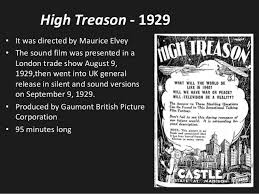
It is set in the far distant future of 1950 where face-time phone calls are the norm at the top of the social pole.
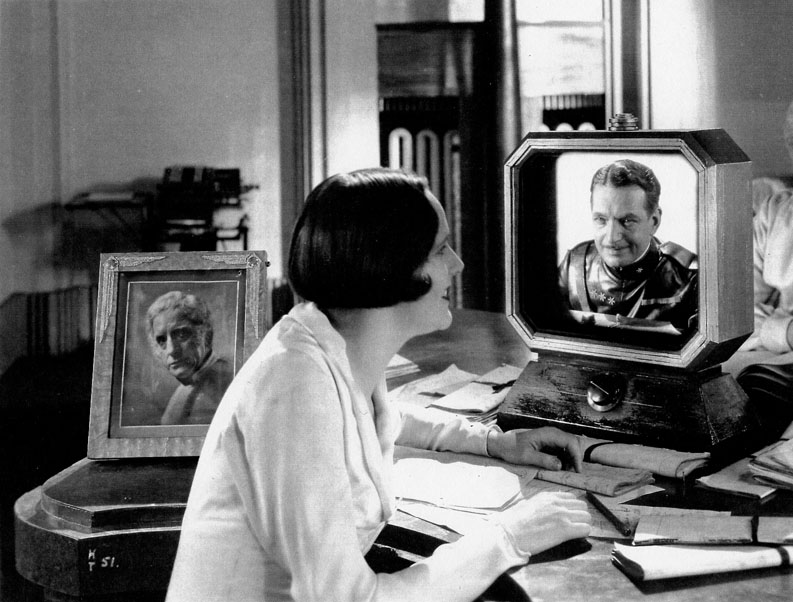
We never see any proles. Everyone of the elite scoots around in a personal airplane. Art Deco is über alles. The gear is all sleek and flapper with cloche hats. Fantastic, perhaps, but the clipboard is much in evidence. Not a computer in sight. But rows and rows of clerks adding things up. What things? Dunno.
The post-Great War world is divided into the Federated States of Europe and the Atlantic States, as illustrated on a map. Did Eric Blair see this movie?
Somewhere there is a land border between these two. Greenland? Bermuda? Wales?
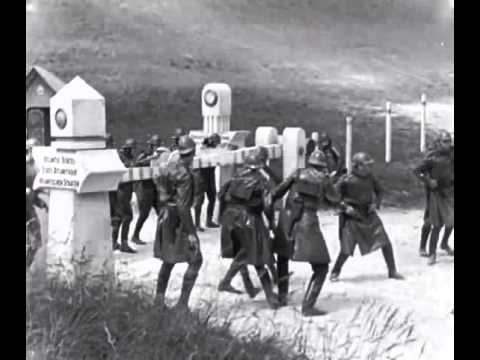
At the border the opposing guards play cards and joke about another war. A futuristic car pulls up and much suspect behaviour ensues. Will they declare the duty free or not? Not! Finally the car breaks away and shooting follows. The guards in the best NRA training start shooting each other rather than the fleeing automobile, which looks like a low-slung rocket on wheels. We never do find out what this is all about except that the guards are trigger happy, and that is well conveyed.
The blame bat swings and the politicos on each side of the border pontificate and bluster. All this is observed over a tele-screen by a room of bearded men in a smoke filled room who are spying on the politicos and brag about manipulating them. These are the plutocratic merchants of death. They are indicted by the film for encouraging war, but how they caused those border guards to go all NRA is never explained.
Once the bluster starts it has no end. See Barbara Tuchman’s ‘The Guns of August’ reviewed elsewhere on this blog.
In a parallel path we have the World Peace League, which is compromised mainly of women who wear white. There is a lot of white. There are millions of members, but, of course, the head is a man, ahem, whose daughter is betrothed to a soldier. The Montagues and Capulets at it again.
When Romeo and Juliet go to a ball and dance there is marvellous scene with an automated orchestra and a mechanical dance. The scale is great but the movements are stiff and poorly timed, by purpose, to reflect the pace of the instruments. At least that is what I think the point was.
Dad Montague is president of the Atlantic States and keen for war. No reason is offered for his belligerence; he is just written that way. Romeo Montague is a pilot who is ordered to bomb the Federated States of Europe, which is headquartered in London. Juliet Capulet in white harangues one and all campaigning for the Nobel Peace Prize or at least the Sydney one.
There follow two confrontations. One is choreographed like Busby Berkley at the aerodrome between the bomber pilots in slick black leather gear, and the women in white, lots of them. They mill around, confront, mill some more, while Romeo dithers. This scene is very nicely staged. The pilots have to get to those boy toys so they can blow people up, and quick! Guns are drawn, but…
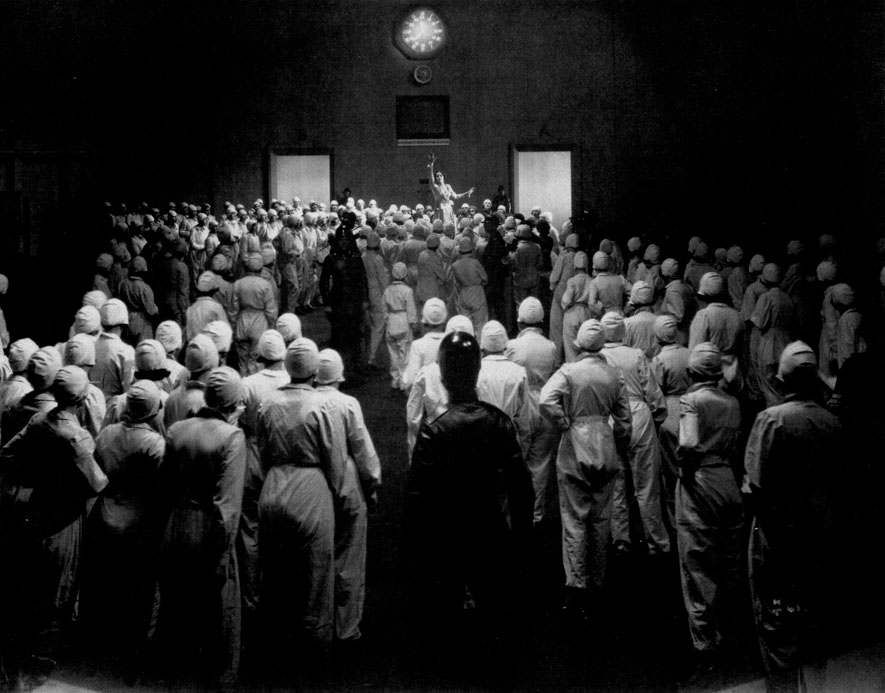
Meanwhile, Dad Capulet in white goes to see President Montegue in his private sanctum. In passing we learn that many chaps are keen for another war, though there are some chaps who know better in white, too. Not a white feather is sight. Boys Own stuff. This man of peace carries in his pristine, moral high ground white clothing a gat. A smile comes to the NRA composite. Got a problem. Shoot it! Problem gone.
Ah…. Peace now prevails in this world of personal rule. No more detail about this miracle is offered. If Hitler had been murdered at Munich….? Well, then perhaps Reinhard Heydrich for Führer. Gulp.
Instead we have the trial of Dad Montague in white for murdering President Capulet in black. The judge, determined to make the law an ass, rules irrelevant all matters of context and intention. A life for a life is the rule he knows. Though the jurors are anguished cravenly they comply with the direction of the judge, and he is sentenced to death, left then staring at the camera, while Romeo comforts Juliet. He never seems to note or care about the murder of his dad. Will the Federated States now launch an attack. Unknown. Maybe they are having their own white and black confrontation. Who knows.
That is where the version I watched faded. Fine with me. It is available for Free View from BFI web site, but I cannot access that. I found it on the Internet Archive and mirrored it to the Apple TV.
The futurism is fun, and the extended Art Deco set design and costumes are noteworthy. The comparison to ‘Metropolis’ is right for the staging, but not the story. War and peace is a big subject, true, but here it reduces to the bad will of a single individual, President Capulet. There is never any indication that the beards with cigars have any influence on Prexie Capulet and they disappear from the film. Or will they return to manipulate his successor into war? ‘Metropolis’ offers a more complex account of good and evil. Nor are there the macabre touches from ‘Metropolis.’
